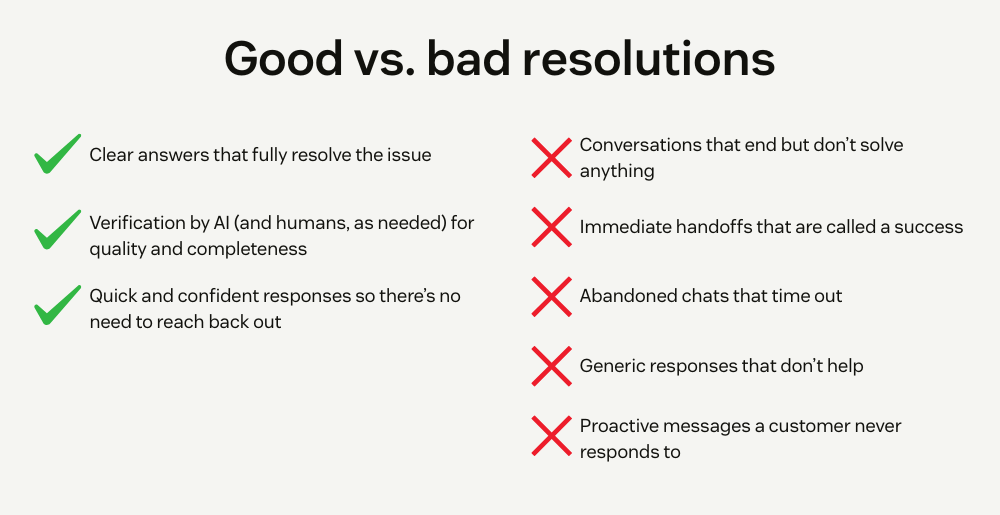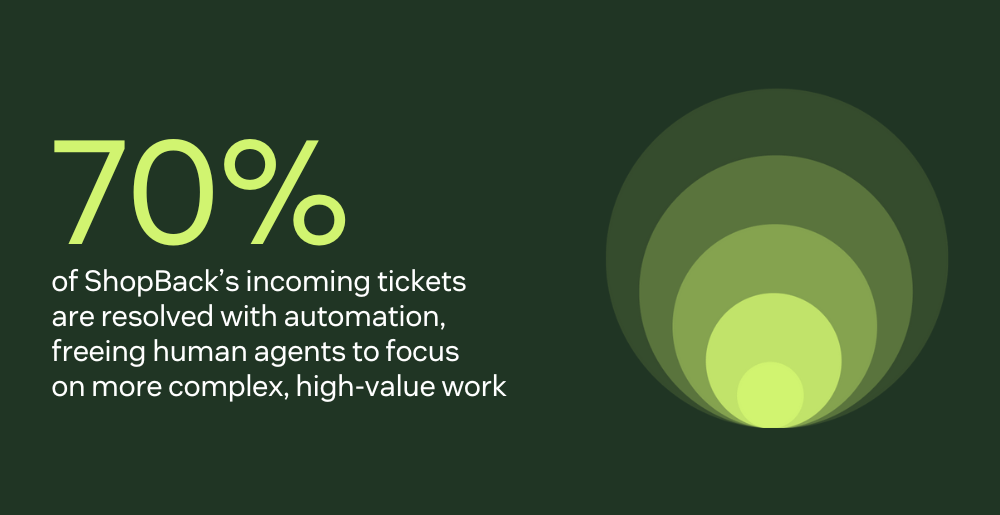Article • 5 min read
Resolution is the only customer service outcome that matters
If your AI is closing tickets but not solving problems, it’s doing more harm than good.
Candace Marshall
Vice President of Product, AI and Automation at Zendesk
Zuletzt aktualisiert: August 18, 2025
It’s hard to deliver great service if you aren’t actually resolving a customer’s issue. Most customers wouldn’t count a dropped call or a timed out chat as resolution, and you shouldn’t either. But many companies say it is—and charge you for it, too.
Resolution isn’t deflection. It’s not a half-baked handoff or a conversation that simply ends. A true resolution is when the problem is fully solved. And if a customer has to reach back out or gets stuck between departments with no end in sight, you’re just not meeting the mark.
Here’s the issue: most AI vendors and platforms are optimizing for activity, or the number of engagements or deflections, rather than outcomes. A bot can easily respond to thousands of conversations a day, but if it’s not delivering true resolution, you’re scaling false success quickly.
At Zendesk, we believe resolution is the only customer service outcome that matters—so much so that we’ve built our entire platform and pricing model around resolutions that actually resolve.
What resolution should look like
Resolution should be a straightforward concept, but the definition used across the market varies wildly.
We think resolution should do exactly what the word promises: solve the customer’s problem, fully and accurately. That means the issue is addressed, confirmed, and closed without follow-ups, confusion, or botched handoffs.

Here’s how we define a good resolution:
A clear answer that fully resolves the inquiry
Verified by AI (and sometimes human review) for completeness
Delivered quickly and confidently, with no need to reach back out
That should be it—a simple, three-point list. But too often, other platforms include far more by counting resolutions that may look good in dashboards, but feel terrible to customers.
What they count as “resolved”:
Conversations that end, but don’t solve anything
Customer asks, “What’s the status of my refund?” and gets a reply: “Refunds are processed in 5-7 business days.” The conversation ends with no confirmation of whether the refund was issued, to what order, or when it will arrive.
AI agents that immediately escalate and call it a success
Customer says, “I need to reset my password, but I’m locked out of my account.” They’re immediately transferred to a human agent, but no agent is available and the call disconnects.
Abandoned chats that time out
What they count as “resolved”: Customer types, “I was double charged, can you fix this?” An automated response says, “Let me look into that.” The customer steps away and the conversation times out.
Generic responses that sidestep the issue
Customer says, “I want to cancel my flight for a refund” and receives an automated response telling them they can manage bookings in their account settings. Conversation is closed with no confirmation of cancellation or refund issued.
Proactive messages sent by the business, even if the customer never responds
A retailer’s AI agent sends a proactive message, “Need help finding the right size?” The customer doesn’t respond.
Cutting corners like this is becoming all too commonplace. Many platforms now automatically log a resolution after a short fix time window, whether the customer got what they needed or not. They’re optimizing for speed, touch rate, and deflection volume—but customers care about results.
That’s why our pricing model is tied directly to verified outcomes. We don’t charge you if AI responds quickly, but isn’t helpful.
Why real resolutions are so important
Customers aren’t here for the chat. They’re reaching out because they actually need help. Supporting them in that moment not only increases customer satisfaction and long-term loyalty, but it also reduces your costs by solving problems the first time around.
Take ShopBack, Asia-Pacific’s number one rewards and discovery platform. They’re now resolving 70% of all incoming tickets with automation—yes, actual resolutions that don’t require follow-up. As a result, agents have more time to spend on complex work and customer satisfaction continues to rise.
“The old world was message in, response out. Real customers change their minds, ask clarifying questions, and expect the AI to follow along naturally. In service, the only outcome that matters is resolution, and until now, bots have been somewhat limited in their ability to achieve it.”
– Adrian McDermott, Chief Technology Officer at Zendesk
But when organizations don’t actually resolve customer issues, they undermine customer trust and face higher operational overhead from escalations and churn. We know the importance of getting customers what they need and not just leaving them in the queue. That’s why we don’t just promise resolution, we define it, track it, and prove it—or you don’t pay.

At Zendesk, we set the highest bar in the industry for what counts as an automated resolution. Each must be confirmed with two layers of validation:
Rule-based checks that make sure it’s a genuine support request, handled end-to-end by the AI agent.
An AI assessment to review the entire conversation and confirm that the customer’s problem was actually solved.
In addition, our generous 72-hour resolution window means you’re never charged for abandoned chats, incomplete sessions, or the same issue counted twice—even if a customer comes back within that period.
Few vendors stand behind their AI like this. We only succeed when our customers do, so if the conversation doesn’t clear these hurdles, there’s no charge.
Resolution without the runaround
At Zendesk, we’re setting a new standard for how AI in service should be measured and trusted. We don’t count quick touches, closed tickets, or deflections as victories. We measure success by whether the customer walks away with their problem solved and we back it up with a model that only charges for resolutions that meet that standard.
Because in customer service, the only thing that matters more than speed is resolution. Get it right the first time, and you’ll earn something far more valuable than a closed ticket: lasting customer loyalty that powers your bottom line.
